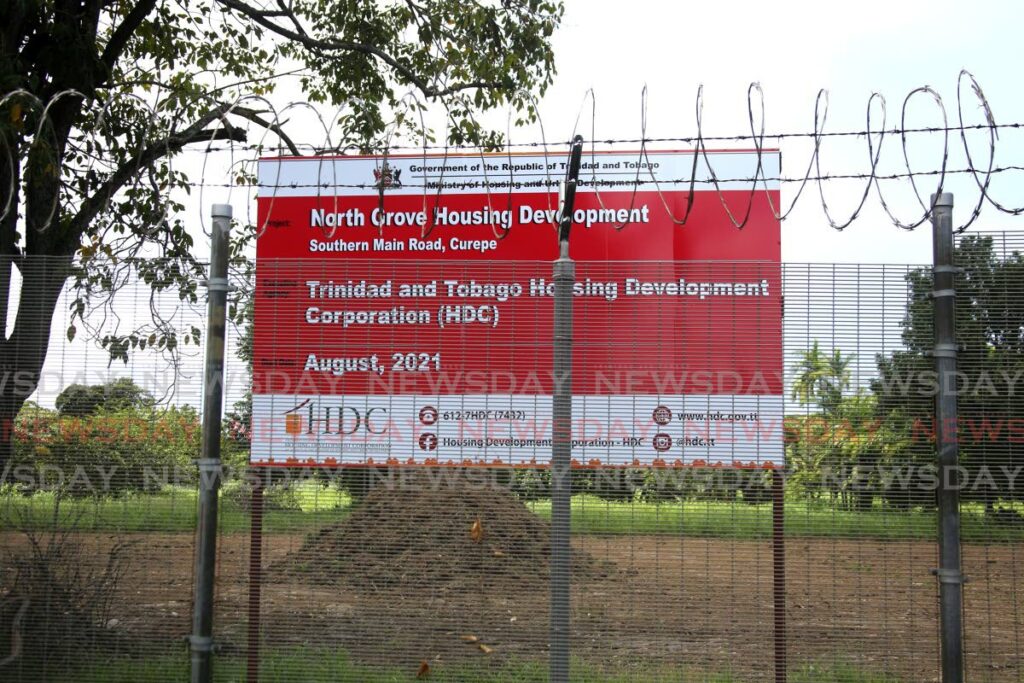Court stops HDC's St Augustine nurseries site project

GOVERNMENT’S proposal to use the St Augustine nurseries for housing hit a snag when a High Court judge granted an injunction restraining the Housing Development Corporation (HDC) from starting any work on the site.
On Tuesday, Justice Robin Mohammed gave permission to environmentalist Dr Wayne Kublalsingh and livestock farmer Shiraz Khan to challenge a decision by the Environmental Management Authority (EMA) to grant a certificate of environmental clearance (CEC) to the HDC.
The judge also granted the temporary injunction to prevent work from starting or continuing on the site until the judicial review application is determined in court. The matter comes back up for a virtual hearing on September 13.
Mohammed allowed the judicial review application, giving permission for the two men to seek an order to quash the September 14, 2018 decision by the EMA to issue the CEC to the HDC to build a 504-unit multi-family residential development at Farm Road, St Joseph, on seven acres of land.
The proposed site is part of the St Augustine nurseries.
The two men will be asking for a declaration that the EMA’s decision is unlawful and a further order to compel the EMA to demand an environmental impact assessment (EIA) be done before the project can move forward.

In his ruling, the judge said, “My primary concern must centre on the decision-making process and not the decision itself. I must consider whether the EMA’s decision was illegal, irrational, or procedurally improper.”
In determining if the men’s argument had a realistic prospect of success, the judge said he found the report submitted by the men’s experts to be useful.
One in particular as it related to the shortcomings and inconsistencies in the HDC’s application was referred to by the judge.
“Such (shortcoming and inconsistencies) include the error of HDC that there were no springs or aquifers in or adjacent to the site and that there were no rivers, streams, or drainage as well as its omissions with respect to the assessment and treatment of domestic solid waste.
“In fact, significant doubt was cast on the reliability and accuracy of the scope of works provided by HDC, particularly with respect to its revised plans including drainage site plan and calculations and the stormwater management plan.
“These inconsistencies and contradictions suggest the EMA’s assessment of the information provided by the HDC with respect to the impact on the aquifer and the hydrological system was insufficient. This raises questions as to the rationality of the decision to grant the CEC.”
He said it was submitted by the EMA its role was not to encroach on the HDC’s division of the land, for which it received approval, but to determine if the development would pose a threat to the surrounding environment, including the St Joseph Farm and the St Augustine nurseries.
“I do not consider this argument of the EMA to be relevant.”
Judge: EMA should have asked more questions
He said Kublalsingh and Khan were not challenging the use of the land but questioning the EMA’s failure to enquire from the HDC on the impact of the project on the micro-climate of the farm which borders the proposed development.
He also said the lack of evidence of engagement with the Ministry of Agriculture, which controlled the lands, also cast doubt on whether the EMA had a fulsome picture of the potential adverse short-term and long-term environmental impact on the propagation station contiguous to the development, the potential risks to the St Joseph farm and St Augustine nurseries, and other likely adverse effects.
“There is also no evidence that the EMA engaged the ministry otherwise.”
He also said it was evidence the environmental risks identified by the applicants spoke to long-term impacts of the proposed development and no such impacts were identified by the EMA.

“In fact, limited evidence and detail are provided by the EMA in its assessment of the impact on the nursery.
“...In the circumstances, I am not satisfied that these grounds have no realistic prospect of success.”
It was proposed that the North Grove development would be located on seven acres of agricultural land being used for experimental crops.
The application said the HDC cited an August 2017 Cabinet Minute #1376 which stated that “although the parcel of land is presently used for agricultural purposes, it is located in a densely built-up urban area, surrounded to the south, north, and east by built development, including commercial and residential uses.”
The men are represented by attorneys Dinesh Rambally, Kiel Taklalsingh, Stefan Ramkissoon, and Arya Mahabir while Ian Benjamin, SC, Tekiyah Jorsling, and Maurice Wishart represented the EMA.
In their application, the two men said the EMA acted illegally and failed in its statutory duty to consider all relevant matters before deciding to issue the CEC.
They accused the HDC of providing false and misleading information to the EMA when it applied for the CEC in October 2017. According to the application, the men alleged the HDC said there were no springs or aquifers at the site or near to it. However, they claim the project site lies over the Valsayn aquifer.
The application also contended that the EMA was aware that the land on the St Augustine nurseries is agricultural land and part of a larger enclosed parcel.
“It failed to request information of the HDC and/or to require a study of and/or require an examination of the impact of an extensive piece of housing infrastructure, namely the construction of twelve high rise buildings, each eight stories high, on the microclimate of the farm upon which the valuable tree and plant stocks of the contiguous St Augustine nurseries rely.”
The application further accused the EMA of failing to ask for information or demand a study be done to determine potential risks or negative impacts on the propagation station which dispenses plant and tree crops to farmers and the general public.
EMA: We did our job correctly
The St Augustine nurseries is part of the St Joseph Farm which was established in the 1930s and was part of an economic plan for the collection, conservation, and dissemination of tropical plant species and products.
The plan included agricultural education and large tracts of land were allocated for research and conservation the lawsuit contends.
“Part of the farm, the St Augustine nurseries collects, conserves, and propagates plant material, germplasm. It keeps integrated a unique bank of plasm and technical expertise developed and preserved over nine decades. The farm also houses a herbarium. Both the nursery and herbarium are directly west of the proposed housing scheme,” the application added.

In resisting the application, the EMA contended Kublalsingh and Khan did not act with promptitude in making its application and cited the delays it would have in the national development of housing,
The EMA also argued that the grant of leave would be prejudicial and detrimental to good administration by further delaying a much-needed public project which will benefit middle and low-income families.
It was argued the EMA properly considered the environmental impact of the development and was satisfied that the impact was minimal and could be properly mitigated and its approach was reasonable and consistent with the precautionary principle as it took a hard look at the adverse impacts prior to granting the CEC.
It also maintained an EIA was not a mandatory requirement under the EMA Act and in this case, it was not necessary.

Comments
"Court stops HDC’s St Augustine nurseries site project"